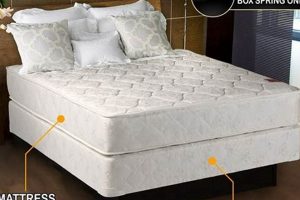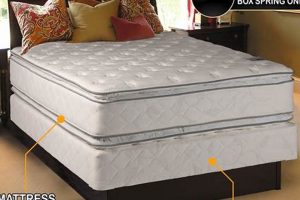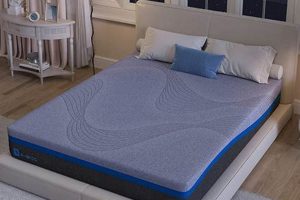A complete bed setup often includes a mattress and a foundation designed to work together. This pairing provides support and comfort for sleep. The foundation, traditionally a box spring, elevates the mattress and absorbs shock, contributing to its longevity and the sleeper’s overall experience. For example, a standard 54-inch wide by 75-inch long mattress paired with its corresponding foundation creates a suitable sleep surface for individuals or couples with space constraints.
Acquiring a coordinated sleep system offers several advantages. It ensures proper support, potentially alleviating back pain and promoting better spinal alignment. Furthermore, using a compatible foundation can validate the mattress warranty, as some manufacturers require specific foundation types. Historically, foundations were primarily coil-based, but contemporary options include solid platforms and adjustable bases, catering to diverse needs and preferences.
The following sections will delve deeper into the specifications, considerations, and selection process involved in choosing the right mattress and foundation to optimize sleep quality and overall well-being. Understanding the intricacies of these components is crucial for making an informed purchase and achieving a restful night’s sleep.
Essential Considerations for Acquiring a Complete Mattress and Foundation
The selection of a coordinated mattress and foundation requires careful consideration to ensure optimal sleep quality and long-term value. The following points provide essential guidance for navigating the purchase process.
Tip 1: Assess Space Constraints: Prior to purchase, accurately measure the intended bedroom space to guarantee the chosen size comfortably fits without obstructing movement or other furniture.
Tip 2: Evaluate Support Needs: Determine the level of support required based on sleeping position and body weight. Side sleepers often benefit from softer mattresses, while back and stomach sleepers may require firmer support to maintain spinal alignment.
Tip 3: Research Foundation Compatibility: Confirm that the chosen foundation is compatible with the mattress type to avoid voiding the warranty or compromising the mattress’s structural integrity. Platform foundations, for example, may not be suitable for all mattress types.
Tip 4: Consider Material Composition: Investigate the materials used in both the mattress and foundation. Look for hypoallergenic and breathable materials to minimize allergens and promote airflow, contributing to a more comfortable sleep environment.
Tip 5: Review Warranty Terms: Carefully examine the warranty terms and conditions offered by the manufacturer. Pay attention to the length of the warranty and the specific conditions that may void coverage.
Tip 6: Explore Different Foundation Types: Investigate alternatives to traditional box springs, such as platform foundations, adjustable bases, and slatted frames, to determine which option best suits individual needs and preferences.
Tip 7: Read Customer Reviews: Consult online reviews and ratings from other consumers to gain insights into the real-world performance and durability of the mattress and foundation being considered.
These considerations are crucial for making an informed decision. Choosing a well-matched set ensures optimal support, comfort, and longevity of the sleep system, promoting restful sleep and overall well-being.
The subsequent sections will provide a deeper dive into specific types of mattresses and foundations, as well as guidance on proper maintenance and care to extend the life of the investment.
1. Dimensions
The dimensions of a mattress and its accompanying foundation are fundamental considerations in the selection of a complete sleep system. Standardized sizing exists to ensure compatibility and facilitate informed purchasing decisions. A so-called “full-size” mattress, measuring approximately 54 inches in width and 75 inches in length, requires a similarly sized foundation. Deviation from these dimensions can result in inadequate support, mattress overhang, or instability of the entire structure. For example, placing a smaller mattress on an oversized foundation negates the intended support and weight distribution, potentially accelerating wear and tear.
Accurate measurement of the intended bedroom space prior to purchasing is crucial. Constraints imposed by room size may dictate the feasibility of accommodating a “full-size” bed, especially when factoring in additional furniture and accessibility. For instance, a small bedroom might necessitate downsizing to a twin or twin XL option to ensure adequate maneuverability. Conversely, a larger room allows for greater flexibility in selecting a queen or king-size bed, provided the dimensions are compatible with the overall spatial arrangement. Mismatched dimensions between the mattress and foundation not only compromise structural integrity but can also void manufacturer warranties.
In summary, the dimensions are a critical aspect of a complete sleep system. Proper alignment between the mattress and foundation is essential for structural stability, optimal support, and adherence to warranty requirements. Careful consideration of bedroom space limitations is paramount to ensuring a functional and aesthetically pleasing arrangement. Ignoring the dimensional requirements could lead to premature degradation of the mattress, reduced comfort, and financial losses due to voided warranties or the necessity of replacement purchases.
2. Support System
The support system within a mattress and foundation pairing serves as the core structural element responsible for distributing weight, maintaining spinal alignment, and contributing to the overall comfort and longevity of the sleep surface. In the context of a full-size configuration, the support system must adequately accommodate the weight and pressure exerted by one or two individuals, preventing sagging and ensuring consistent surface firmness. The mattress support is typically provided by innerspring coils, foam layers, or a hybrid construction, while the foundation, often a box spring, contributes to support, elevation, and shock absorption. The interplay between these two support components directly impacts the quality of sleep and the potential for musculoskeletal strain.
A deficient support system can manifest in several detrimental ways. For example, a worn or improperly designed box spring can cause uneven weight distribution, leading to localized mattress sagging and discomfort. This, in turn, may result in back pain, restless sleep, and reduced mattress lifespan. Conversely, a robust and well-engineered support system, such as a pocketed coil mattress paired with a solid platform foundation, can provide enhanced spinal support and minimize motion transfer, benefiting couples with different sleep habits. Furthermore, the foundation’s role in elevating the mattress facilitates airflow, reducing moisture buildup and inhibiting the growth of mold and mildew.
In summation, the support system is an indispensable component of a full-size mattress and foundation, directly influencing comfort, durability, and health. A thorough understanding of the different support system types and their respective strengths and weaknesses enables informed decision-making. Addressing this aspect comprehensively translates to a more restful sleep experience and a longer lifespan for the sleep set. While the initial cost of a high-quality support system may be higher, the long-term benefits in terms of sleep quality and mattress longevity typically justify the investment.
3. Material Quality
The longevity and performance of a mattress and foundation arrangement are intrinsically linked to the quality of the materials used in their construction. Inferior materials degrade more rapidly, leading to a reduction in support, diminished comfort, and a shortened lifespan. For a full-size mattress set with box spring, the impact of material quality is amplified due to its typical use by one or two individuals, placing consistent stress on the components. Low-density foams, for instance, compress prematurely, resulting in sagging and inadequate spinal alignment. Similarly, poorly constructed box springs with weak frames or low-grade coils offer insufficient support, accelerating mattress wear and potentially causing structural failure. The selection of durable, high-quality materials is, therefore, a critical determinant of the sets overall value and long-term suitability for sleep.
The type of materials also influences other factors beyond durability. Breathability, hypoallergenic properties, and resistance to dust mites are all material-dependent characteristics. Mattresses constructed with natural latex or open-cell foam promote airflow, reducing heat retention and creating a cooler sleep environment. Covers made from organic cotton or bamboo are less likely to trigger allergic reactions and provide a softer, more comfortable surface. Conversely, synthetic materials may trap heat and harbor allergens, leading to discomfort and potential health issues. A carefully chosen set made of superior materials not only offers increased comfort and support but also contributes to improved sleep hygiene and overall well-being.
In conclusion, material quality represents a fundamental consideration when selecting a full-size mattress set with box spring. The choice of materials impacts durability, comfort, and health, influencing the sets long-term performance and value. While higher-quality materials may entail a greater initial investment, the benefits of enhanced support, improved sleep, and extended product lifespan often outweigh the increased cost. Consumers should prioritize sets that utilize durable, breathable, and hypoallergenic materials to ensure a restful and healthy sleep experience.
4. Warranty Coverage
Warranty coverage represents a critical component of a full-size mattress set with box spring purchase, providing recourse against manufacturing defects and premature product failure. Mattress and box spring warranties typically cover issues such as sagging exceeding a specified depth, broken coils, or structural defects arising from normal use. However, warranties often exclude damage resulting from misuse, stains, burns, or improper support. The duration of the warranty varies among manufacturers, ranging from a few years to several decades, and the specific terms and conditions delineate the scope of coverage. The absence of adequate warranty coverage exposes the consumer to the full cost of repair or replacement should a defect manifest within a reasonable timeframe. Real-world examples include consumers experiencing significant sagging within a year of purchase, only to discover their warranty excludes such issues due to specific usage limitations. Understanding the nuances of warranty coverage is therefore paramount for protecting ones investment in a full-size mattress set.
The interaction between the mattress and box spring can directly influence warranty validity. Many mattress manufacturers stipulate that the mattress must be used with a compatible foundation, often specifying a particular type or brand. Using an incompatible or damaged box spring can void the mattress warranty, as the improper support may contribute to premature wear and tear. For example, a mattress placed on a broken or sagging box spring is more likely to develop sagging itself, but this damage may not be covered under the warranty if the box spring was deemed unsuitable. Consumers should meticulously review the warranty terms and conditions to ensure compliance with foundation requirements and other stipulations to maintain coverage. Furthermore, retaining proof of purchase and diligently following maintenance recommendations, such as regular mattress rotation, is essential for facilitating successful warranty claims.
In summary, warranty coverage serves as a crucial safeguard for consumers investing in a full-size mattress set with box spring. Comprehending the specific terms, conditions, and exclusions of the warranty is essential for protecting against manufacturing defects and premature product failure. Ensuring compatibility between the mattress and box spring, adhering to usage guidelines, and maintaining proper documentation are all critical steps in maximizing the value of the warranty. While a warranty cannot prevent defects, it provides a mechanism for redress and peace of mind, mitigating the financial burden associated with unexpected product failure.
5. Foundation Type
The foundation type exerts a significant influence on the performance and longevity of a “full size mattress set with box spring.” Its primary role involves providing stable support, elevating the mattress, and absorbing impact, thereby contributing to the sleeper’s comfort and the mattress’s durability. Common foundation types include traditional box springs, platform beds, adjustable bases, and solid or slatted frames. Each option presents distinct characteristics affecting support level, airflow, and overall cost. A mismatched foundation can compromise the mattress’s structural integrity, potentially leading to premature sagging or voiding manufacturer warranties. For example, placing a memory foam mattress, designed for a solid surface, on a traditional box spring with excessive give can result in uneven weight distribution and accelerated wear. The correct foundation type is thus integral to maximizing the benefits of the complete sleep system.
Practical considerations when selecting a foundation type for a “full size mattress set with box spring” extend beyond mere compatibility. Platform beds, characterized by their solid or closely spaced slats, offer firm support and eliminate the need for a separate box spring. This design is advantageous for individuals seeking a lower bed profile or desiring enhanced support for heavier mattresses. Adjustable bases, conversely, provide customizable support and positioning, catering to individuals with specific medical needs or lifestyle preferences. A real-life example involves individuals with acid reflux who find relief from elevating the head of their mattress using an adjustable base. The choice of foundation therefore necessitates an evaluation of individual needs, mattress type, and budget constraints.
In conclusion, the foundation type represents a critical determinant of the overall performance and value of a “full size mattress set with box spring.” Selection should be based on a careful assessment of mattress compatibility, support requirements, and personal preferences. Failure to choose an appropriate foundation can compromise mattress longevity, diminish comfort, and potentially invalidate warranties. Prioritizing informed decision-making regarding foundation type is therefore essential for optimizing the sleep experience and safeguarding the investment in a complete sleep system.
Frequently Asked Questions
The following addresses commonly encountered questions regarding the acquisition, usage, and maintenance of a complete sleep system. These answers are intended to provide clarity and promote informed decision-making.
Question 1: What are the standard dimensions of a full size mattress set?
A “full size” mattress typically measures 54 inches in width and 75 inches in length. The corresponding box spring is designed to match these dimensions, ensuring proper support and alignment.
Question 2: Is a box spring necessary for all full size mattresses?
A box spring may not be necessary if the mattress is used with a platform bed or adjustable base, which provide sufficient support. However, some mattress warranties stipulate the use of a box spring, so the warranty terms should be consulted.
Question 3: How often should a full size mattress be rotated?
A mattress should be rotated every six months to promote even wear and prevent sagging. This practice helps to extend the lifespan of the mattress and maintain optimal comfort.
Question 4: What is the typical lifespan of a full size mattress set?
The lifespan of a mattress set depends on the quality of materials and the frequency of use. A well-maintained set can last for seven to ten years, although some may require replacement sooner.
Question 5: How can a stain be removed from a full size mattress?
Stains should be addressed promptly using a mild detergent and water. Harsh chemicals should be avoided, as they can damage the mattress fibers. Professional cleaning services may be required for stubborn stains.
Question 6: Can a full size mattress be flipped?
Many modern mattresses are designed for one-sided use only and should not be flipped. Rotating the mattress is sufficient for promoting even wear. The manufacturer’s instructions should be consulted for specific recommendations.
These questions and answers provide a baseline for understanding the essential aspects of a full-size mattress set with box spring. Careful consideration of these points can lead to a more satisfactory and enduring sleep experience.
The following section will transition to preventative maintenance strategies to prolong the life and quality of a full-size mattress set.
Concluding Thoughts on Full Size Mattress Set with Box Spring
The preceding exploration has underscored the multifaceted considerations involved in selecting a suitable sleep system. From dimensional compatibility and support systems to material quality, warranty coverage, and foundation types, each element contributes to the overall performance and longevity of the ensemble. A judicious approach to these factors, informed by individual needs and preferences, is paramount for maximizing the investment and achieving restorative sleep.
The selection of a full size mattress set with box spring represents a significant decision that directly influences health, comfort, and well-being. Therefore, prospective purchasers are encouraged to engage in diligent research, compare options critically, and prioritize long-term value over short-term cost savings. A well-informed decision ensures a more restful sleep experience and a more enduring investment in personal wellness.






![Best Box Spring for Purple Mattress: [Updated] Guide Organic & Natural Mattress Buyer’s Guide: Non-Toxic Sleep Solutions Best Box Spring for Purple Mattress: [Updated] Guide | Organic & Natural Mattress Buyer’s Guide: Non-Toxic Sleep Solutions](https://mattressworldpa.com/wp-content/uploads/2025/07/th-3364-300x200.jpg)
